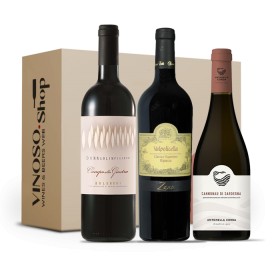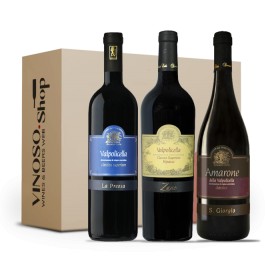- Mondo Vino
- 18736 views

Valpolicella Doc takes the denomination of Valpolicella DOC Classico and Valpolicella DOC Valpantena according to the production area. It is a young wine that should be drunk, preferably, within the year following its production. It has a ruby red color and its scent recalls floral essences, bitter almond, morello cherry, black cherry and spices. In the mouth the Valpolicella DOC expresses a full and velvety flavor with a clear return of aromas and moderate alcohol content. Recommended serving temperature: 16 ° C.
Valpolicella Superiore Doc takes the denomination of Valpolicella DOC Classico Superiore and Valpolicella DOC Valpantena Superiore depending on the production area. Compared to Valpolicella, the Valpolicella Superiore typology is subjected to a mandatory aging period of at least one year. Valpolicella DOC Classico Superiore and Valpolicella DOC Valpantena Superiore wines have lower acidity and greater roundness. Recommended serving temperature: 16-17 ° C.
Valpolicella Ripasso Doc takes the denomination of Valpolicella Ripasso DOC Classico and Valpolicella Ripasso DOC Valpantena depending on the production area. It is one of the most commercially successful wines in recent years. The ripasso is an ancient technique of the master vintners of Valpolicella, used to better structure the base wine produced in the area. After the harvest, the best bunches, selected for the production of Amarone or Recioto, are left to dry for four months on special wooden and bamboo racks, called arelle, in ventilated rooms called Fruttai, while the remaining bunches are pressed immediately after harvest to produce Valpolicella, both in the classic and superior version. In January the fermentation of the dried grapes begins and consequently in February the drawing off of the Amarone takes place and the Valpolicella wine is placed for a certain period on the Amarone or Recioto pomace in order to acquire part of the perfumes and aromas. Originally this was a fairly quick step, in fact the Ripasso operation must take place in a single solution with a minimum duration of three days, hence the name ripasso, then it was understood that a longer stay helped to acquire flavors and aromas . Many producers continue this practice, normally used for Valpolicella Superiore. In recent years, some wineries have refined and modernized the ripasso technique. At the time of harvest, part of the grapes used for Valpolicella are pressed and part withered for a few months as is the case with Amarone. Once these dried grapes have also been pressed, they are combined with those previously processed and undergo a second fermentation before moving on to the subsequent aging in cask. The wine thus obtained, for body, structure and aromas, is halfway between the classic Valpolicella Superiore and Amarone. Valpolicella Ripasso must contain a mandatory percentage of 10%, up to a maximum of 15%, of wine suitable for becoming Amarone or Recioto. The wine destined for Valpolicella Ripasso and the pomace must belong to the same producer who carries out, or has carried out on his own account, the refermentation operations to obtain this type of wine. The color of Valpolicella Ripasso DOC is deep red, with a pleasant aroma and a full and velvety flavor. Recommended serving temperature of Valpolicella Ripasso DOC: 17 ° C.
Valpolicella Recioto Docg takes the name of Recioto della Valpolicella DOCG Classico and Recioto della Valpolicella DOCG Valpantena depending on the production area. Recioto comes from a period of drying of the grapes on racks called arelle, of about 120 days in airy rooms, called fruit-stands. Grapes cannot be claimed for the production of Recioto before the fourth year of life of the vineyard. The Recioto della Valpolicella DOCG is well structured, with a minimum alcohol content of 14%. The color of the Recioto is a rather deep garnet red while the nose releases aromas of black cherry, violet and spices (cinnamon, pepper, nutmeg). Recioto della Valpolicella DOCG wine is sweet, velvety, warm and enveloping on the palate. It lends itself to being sparkling with excellent results: in this way a Recioto Valpolicella Spumante can be obtained. Recommended serving temperature: 14-15 ° C.
Amarone Valpolicella Docg takes the name of Amarone della Valpolicella DOCG Classico and Amarone della Valpolicella DOCG Valpantena according to the production area. Amarone is also obtained by pressing the dried grapes in fruit rooms. The grapes destined to become Amarone must come from vineyards that have reached at least the 4th vegetative cycle. Unlike Recioto, Amarone wine undergoes a compulsory aging period which can last from two to four years (in which case it takes the qualification "Riserva"). The long rest in oak barrels allows Amarone to exhaust, through prolonged fermentation, the residual sugar and to fully develop that opulence and complexity of organoleptic nuances that characterize it. Amarone is very full-bodied and characterized by an alcohol content that is around 15-16 degrees. The color of the Amarone wine is a bright garnet red while the scent is spicy (cinnamon, walnut husk) with notes of jam. In the mouth this Valpolicella wine releases a majestic, velvety, warm flavor. Amarone Valpolicella is today one of the most sought-after fine wines in the world. Recommended serving temperature: 17-20 ° C.


